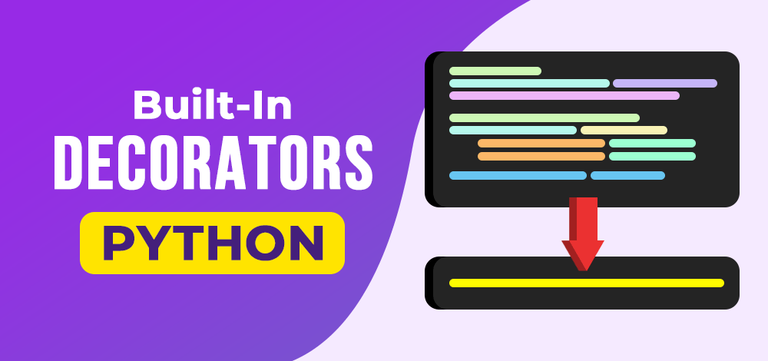5 Reasons Python Decorators Boost Your Code Efficiency

Python Decorators: Enhancing Code Efficiency

Decorators in Python, a powerful feature, significantly enhance the efficiency and readability of your code. Here are five reasons why incorporating decorators into your Python code can be a game-changer:
1. Reduced Code Duplication

One of the primary benefits of decorators is their ability to eliminate code duplication:
- Decorators allow you to wrap a function with additional functionality without modifying its core logic.
- This means that common tasks like logging, timing functions, or caching results can be encapsulated in a decorator and applied across multiple functions.
For example, consider a scenario where you need to time several functions to see which one takes longer to execute:
from time import time
def timeit_decorator(func):
def wrapper(*args, kwargs):
start = time()
result = func(*args, kwargs)
end = time()
print(f”{func.name} executed in {end - start} seconds.“)
return result
return wrapper
@timeit_decorator
def long_running_function():
# Function code here
pass
This decorator applies timing functionality to any function without altering the function itself. This approach avoids rewriting the same timing logic for each function, thereby reducing the potential for errors and maintaining a clean codebase.
🔍 Note: Remember that decorators modify the function's behavior by wrapping it. Understanding the context in which you apply decorators is crucial for maintaining readability and functionality.
2. Improved Function Composition

Decorators facilitate the composition of functions, allowing you to build sophisticated functionality by stacking simple, reusable components:
- Multiple decorators can be applied to the same function, each adding its own layer of behavior.
- This stacking allows for a clear, modular approach to function enhancement.
Here's an example of using multiple decorators:
@timeit_decorator
@logged_decorator
def my_function():
# Function code here
pass
In this case, the my_function will be both timed and logged. This composition means you can design your functions to perform complex operations without bloating the function's source code, adhering to the principle of separation of concerns.
3. Enhanced Readability

Decorators improve the readability of your Python scripts by:
- Separating the core logic from auxiliary behaviors.
- Reducing the visual noise within the function body, making it easier for other developers to understand the primary intent of the function.
- Making your code self-documenting, as decorators often convey their purpose clearly through their names.
Using a decorator like @retry for example, immediately informs the reader that the function might retry upon failure without needing to delve into the function's internals:
@retry(max_attempts=3)
def api_call():
# API call logic here
pass
The above snippet succinctly communicates that the api_call function will attempt to execute up to three times before failing, which is significantly more readable than if retry logic were embedded in the function itself.
4. Easy Debugging and Testing

Debugging and testing become more straightforward with decorators:
- By centralizing common behavior in decorators, you can test and debug these behaviors once and apply the fixes globally.
- Debugging is easier since decorators can log function calls, arguments, and return values, providing valuable insight into the program's execution flow.
Here's an example of a decorator for debugging:
def debug_decorator(func):
def wrapper(*args, kwargs):
print(f”Calling function {func.name}“)
print(f”Arguments: {args}, {kwargs}“)
result = func(*args, kwargs)
print(f”Result: {result}“)
return result
return wrapper
@debug_decorator
def multiply(x, y):
return x * y
Applying this decorator to the multiply function allows you to see when and how it's called, making the debugging process more efficient.
5. Facilitates Aspect-Oriented Programming

Decorators are a practical implementation of Aspect-Oriented Programming (AOP) in Python:
- They enable you to add cross-cutting concerns like logging, security, caching, or performance monitoring in a clean, modular way.
- AOP principles focus on the separation of concerns, which decorators facilitate by isolating aspects of behavior from the core logic.
Here’s an example of using decorators for AOP:
from functools import wraps
def log_execution_time(func):
@wraps(func)
def wrapper(*args, kwargs):
start_time = time()
result = func(*args, kwargs)
end_time = time()
print(f”{func.name} executed in {end_time - start_time:.4f} seconds”)
return result
return wrapper
@log_execution_time
def complex_calculation():
# Perform a time-consuming calculation here
pass
This approach allows you to manage time-related aspects separately from the logic of the function, adhering to AOP principles.
⚠️ Note: Overusing decorators can lead to obscured logic, especially if the function is heavily decorated. Always strike a balance between modularization and clarity.
Wrapping Up

Incorporating Python decorators into your coding practice offers multiple benefits that lead to more maintainable, readable, and efficient code. By reducing duplication, enhancing composition, improving readability, aiding in debugging, and promoting AOP, decorators help developers write Pythonic, clean code. They provide a means to augment functions in a non-intrusive manner, allowing you to focus on the core logic while offloading secondary behaviors to neatly packaged decorators.
What is the primary benefit of using decorators?

+
The primary benefit is the reduction of code duplication. Decorators allow you to wrap functions with additional functionality without altering their source code.
Can you stack multiple decorators on a single function?

+
Yes, you can stack decorators. They are applied from top to bottom, with each decorator wrapping the result of the previous one.
How do decorators affect function readability?

+
Decorators improve readability by separating the core logic from secondary behaviors, making the code cleaner and more self-documenting.
Is there a performance impact when using decorators?

+
Decorators introduce a small performance overhead due to the additional function calls. However, for most applications, this impact is negligible compared to the benefits they provide.